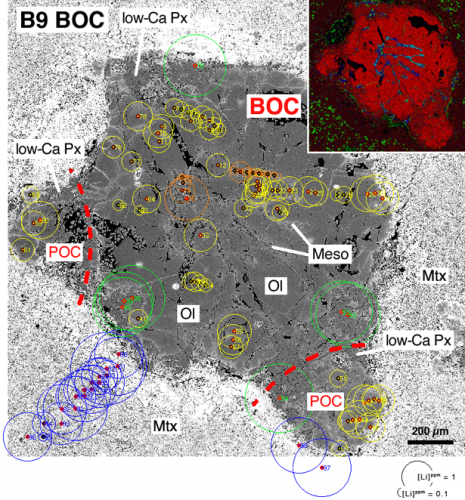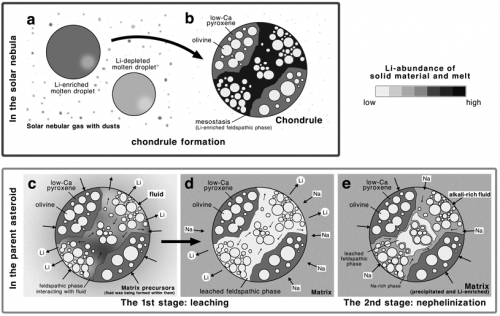Elemental and isotopic abundances of lithium in chondrule constituents in the Allende meteorite
Elemental and isotopic abundances of lithium in chondrule constituents in the Allende CV3 meteorite were determined using secondary ion mass spectrometry. Olivines and mesostasis dominated by a feldspathic phase are depleted in Li (< 1 ppm and 0.1-0.6 ppm, respectively). In contrast, low-Ca pyroxenes and mesostasis dominated by a Na-rich phase are enriched in Li (~ 1-8 ppm and 0.4-3.5 ppm, respectively) and the interchondrule matrix is generally enriched in Li (~ 2.0 ppm on average). The Li isotopic abundance of olivine ranges from δ7Li ~ -32 to 2 ‰. The spatial distributions of elemental and isotopic abundances of Li in olivines within individual chondrules exhibit no systematic pattern. This suggests that the distribution of Li in olivine was not disturbed during aqueous alteration or thermal metamorphism on the Allende meteorite parent body. Although mesostasis is the last crystallizing phase from a chondrule melt and is expected to be enriched in Li, in the Allende meteorite it is generally depleted in Li. We suggest that during aqueous alteration on the CV asteroid, Li in mesostasis was leached out by aqueous fluids. The Li-enriched Na-rich mesostasis was probably produced later by infiltration of Na-rich fluids. It seems likely that aqueous fluids sequestered alkali elements from the Allende-chondrite region in the CV parent asteroid, although significant amounts of Li are preserved in ferrous olivine in the interchondrule matrix.

The [Li] distribution of a barred-olivine chondrule (BOC) named B9 shown on a BSE image. Two secondary porphyritic olivine chondrules (POCs) adhere to primary BOC. Red dotted lines represent boundaries between the primary BOC and the secondary POCs. The dimension of circles located at the analyzed spots is proportional to [Li], and the brightness of symbols corresponds to [Li] (low [Li]—black; high [Li]—bright red). As a result, symbols of olivine (low [Li]) and matrix (high [Li]) are black and bright red, respectively. Yellow, orange, green and blue circles correspond to olivines (Ol), mesostasis (Meso), low-Ca pyroxene (low-Ca Px) and matrix (Mtx), respectively. Combined [Mg]–[Ca]–[Al] map (red:Mg, green: Ca and blue:Al ) is shown at the upper right of this figure. The [Li] distribution of the chodrule olivines is considerably heterogeneous. The Ca-Al-rich mesostasis is highly depleted in Li.

A scenario to explain the observed variations of [Li] among the Allende chondrule constituents and among the individual Allende chondrules. Brightness corresponds to [Li] (low [Li]—white/ high [Li]—black). (a) Chondrule precursors with various [Li] were melted by transient heating. The variation of [Li] among chondrules is inherited from this stage. (b) A molten droplet solidified. Li was preferentially partitioned into melt (mesostasis). After chondrules were accreted to asteroid, (c and d) Li in mesostasis was leached out by aqueous fluids. The matrix materials obtained Li from mesostasis or matrix precursor. (e) The leached feldspathic phase in mesostasis reacted with alkali-enriched fluids and the Na-rich phase was produced preferentially at the chondrule rim and along the grain boundaries (i.e., nephelinization).
References:
- Seiji Maruyama, Masaki Watanabe, Tak Kunihiro, Eizo Nakamura. Elemental and isotopic abundances of lithium in chondrule constituents in the Allende meteorite, Geochimica et Cosmochimica Acta, 73(3), 778-793 (2009). doi:10.1016/j.gca.2008.10.039, dream/20090123132643.hkitagawa.